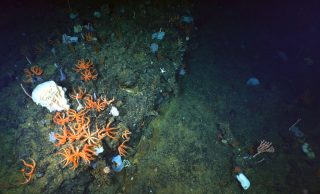Mineral-Rich Habitats of Southern California
The deep sea hosts minerals that contain high quantities of elements that are valuable for human societies. Countries around the world are preparing to develop extractive practices for deep-sea minerals, and baseline biological data are needed to further assess the life that may dwell on or around minerals in different benthic environments. To examine the trade-offs associated with any potential mineral extraction, Drs. Lisa Levin, Paul Jensen, and Greg Rouse from Scripps and Kira Mizell from the US Geological Survey will venture to the Southern California Borderland (SCB) to investigate several sites where marine minerals are known or expected to occur and assess the biological communities living amongst the mineral substrates. The team’s goal is to establish mineral and biological baselines, examine conditions that may influence biodiversity and inspect the therapeutic potential of deep-sea microbes affiliated with mineral-rich areas. The knowledge gained from this expedition will inform policy, management, and stewardship of the deep sea off southern California.
Establishing Baselines in the SCB
The Southern California Borderland (SCB) is a tectonically complicated, rugged, and heavily sedimented region of the California continental shelf that lies offshore between Los Angeles and the Mexico Border. Both ferromanganese (Fe-Mn) crusts and phosphorite marine mineral deposits occur in the SCB. Phosphorite has the potential to be a source of phosphorus for use in agricultural fertilizer, and both Fe-Mn crusts and phosphorites are enriched in rare metals that are used in electronics, green energy, and other technologies. These deep-sea resources are being considered elsewhere in the world for economic development.
Dr. Lisa Levin and her collaborators will document minerals and affiliated species distribution in the SCB, enhancing knowledge of these systems and establishing biodiversity baselines. The team will also create protocols for assessing life in mineral-rich areas through examination of animals and microbes associated with varying benthic environments. By establishing these baselines, we may better understand the biodiversity tradeoffs involved in mineral removal in deep-sea environments and identify habitat features and assemblages that may be in need of conservation. In order to do this, the team will document environmental conditions and the variety of fauna based on factors such as water depth, rock type, oxygen availability, sedimentation, and proximity to shore. The team will utilize a variety of methods to document all shapes and sizes of life, like small invertebrates, deep-sea corals and sponges, demersal fish, and microbes.
A Multitude of Methods for Characterizing the SCB
Hardground habitats of the deep sea are hard to characterize, especially quantitatively. Most characterizations have been done via video for larger animals, but not for smaller animals and microbes, which requires sampling. Using ROV SuBastian, the team will selectively sample and quantify the small animals on rock substrates and in sediments, determine their relationship with microbes, and examine the associations of both biological groups with different geologic habitats. The simultaneous investigation of biology across multiple size scales, microbial characterization, and various geologic substrates are novel aspects of the study.
ROV SuBastian will collect targeted samples of rocks, invertebrates, and microbes to characterize biodiversity. Animals and microbes will also be preserved for DNA analysis to aid identification. The science team will additionally perform detailed analyses on microbial samples in order to categorize diversity and examine therapeutic and industrial potential. They will analyze bacteria collected from the water column, the sediment, rock samples, and invertebrates from each site. Microbial life in the deep sea is poorly studied, though initial estimates suggest the diversity is extensive and distinct from that observed in other habitats.
The team will also collect a series of colonization experiments deployed in 2020 at two depths with different oxygen concentrations of 700 and 1,100 meters. Invertebrate colonization of the rocks, wood, and bone will help expand understanding of animal affinities for different substrates in the deep sea – and whether specific minerals are critical to any specific species. Through this array of methods and analyses across different environments, Levin and her team will create a holistic picture of communities living amongst mineral-rich zones. They will address biodiversity as an ecosystem service, conservation imperatives, and examine if there are alternative values in areas associated with fish and future medicines.
DDT in the Deep
The expedition will spend one day at the DDT Barrel disposal site –collecting sediment cores for analysis of seafloor fauna and microbes in relation to the barrels to determine the accumulation and influence of DDT and its derivatives.
DDT was developed as an insecticide and commonly used in agriculture and households starting in the 1940s in the US until it was banned in 1972. Strong scientific evidence linked DDT as a cause of cancer in humans and pointed to DDT having a catastrophic impact on natural environments.
The information the team will collect on the DDT barrel disposal site will be compared to fauna and microbes on rock and core samples at comparable depths from the SCB region, in order to assess the impact of DDT on the deep sea.
Data & Publications
Benthic macrofaunal data from colonization experiments can be accessed on OBIS’s Deep-sea node.
Raw environmental sensor data can be accessed at Rolling Deck to Repository.
CTD, Event Logger, Navigation, and Imagery from ROV SuBastian can be accessed via MGDS.
Benthic Invertebrate data can be accessed at SIO’s Benthic Invertebrate Collection.
A list of all rock samples collected can be viewed here, with photos of the rocks available here. The rock samples are in Scripps Institution of Oceanography’s rock repository and you can request to samples using this form.
A 3D model of a DDT Chemical Barrer encountered by ROV SuBastian can be viewed here, created by Dr. Greg Rouse from Scripps Institution of Oceanography who was a scientist on the expedition. The model flyover is part of a larger project on DDT dumping off Los Angeles, CA and also includes specimens collected from the sampling conducting during this cruise.
All of the animals collected from the expedition, 695 records in total, have been catalogued into the Benthic Invertebrate Collection.
Supplemental data including macrofauna counts, macrofauna taxonomy, and macrofauna comparisons is available for download here.
Stable isotope data is currently available upon request from UCSD. Please email data@schmidtocean.org to request this data and we will connect you to the scientist.
- 30 Day Preliminary Cruise Report: Biodiverse Borderlands
- Holland, N., Hiley, A., and Rouse, G. (2022). A new species of deep-sea torquaratorid enteropneust (Hemichordata): A sequential hermaphrodite with exceptionally wide lips. Invertebrate Biology, doi: 10.111/ivb.12379. [This article is published as OPEN ACCESS with support from SOI].
- Vlach, D. (2023). An Illustrated Guide to the Southern California Borderland. California Digital Library, Retrieved from https://escholarship.org/uc/item/1hg7v0q0. [This guide has been published OPEN ACCESS].
- Mongiardino Koch, N., Tilic, E., Miller, A.K., Stiller, J., and Rouse, G. (2023). Confusion will be my epitaph: genome-scale discordance stifles phylogenetic resolution of Holothuroidea. Proceedings of the Royal Society, 290, doi: 10.1098/rspb.2023.0988. [This article has been published as OPEN ACCESS].
- Wickstein, M. and Conway, K. (2023). The Chirostyloidea of the Northeastern Pacific: Host Associations, Range Extensions and a New Species (Decapoda: Anomura). Zootaxa, 5284 (1), doi:10.11646/zootaxa.5284.1.7.
- Final Expedition Report: Biodiverse Borderlands
- Guraib, M. (2024). Deep-ocean macrofauna assemblages on ferromanganese and phosporite-rich substrates in the Southern California Borderland. M.S. Thesis, University of California San Diego, USA.
- Pereira, O., Vlach, D., Bradley, A., Gonzalez, J., Mizell, K., and Levin, L. (2024). Invertebrate trophic structure on marine ferromanganese and phosphorite hardgrounds. Limn. and Ocean. 69 (7), doi: 10.1102/lno.12612. [This article has been published as OPEN ACCES].
In the News
Scientists wait for funding after returning with potential DDT samples off Palos Verdes Peninsula
The Daily Breeze • July 13, 2021
Scientists Explore Mineral-Rich Seafloor and DDT Dump Sites
Technology Networks • July 10, 2021
Scientists Explore Mineral-Rich Seafloor and DDT Dump Sites
ROV Planet • July 10, 2021
Scientists explore seafloor, DDT dump sites off SoCal coast
KNX1070 • July 9, 2021
Scripps Scientists Part Of Team Who Explored DDT Dumping Site On Ocean Floor
KPBS • July 9, 2021
Scripps Scientists Explore Mineral-Rich Seafloor and DDT Dump Sites
Peninsula Beacon • July 9, 2021
Chemical ‘Haloes’ And ‘Fried Egg’ Bacteria: A Look At A DDT Dump Site
LAist • July 9, 2021
Mineral-rich seafloor and DDT dump sites reveal new methane seep, whale fall
Phys.org • July 9, 2021
Scripps scientists part of team who explored DDT dumping site on ocean floor
Fox 5 San Diego • July 9, 2021
Ocean Exploration Off California Discovers New Methane Seep, Whale Fall
Marine Technology News • July 9, 2021
Scientists explore mineral-rich seafloor and DDT dump sites; discover new methane seep, whale fall
EurekAlert! • July 9, 2021
Scripps Scientists Part of Team Who Explored DDT Dumping Site On Ocean Floor
Times of San Diego • July 9, 2021





